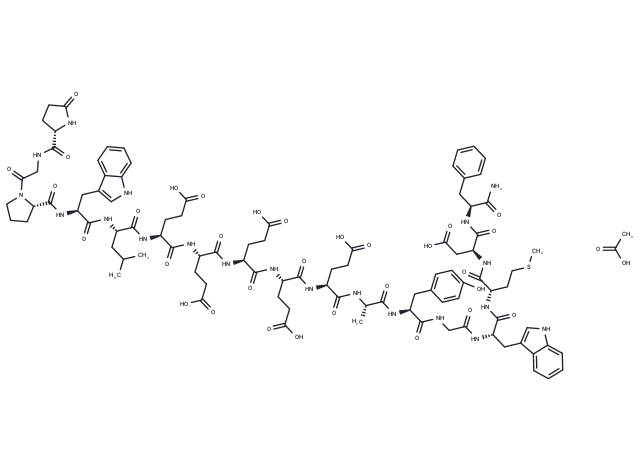Shopping Cart
- Remove All
 Your shopping cart is currently empty
Your shopping cart is currently empty

Gastrin I (human) acetate (Gastrin-17 acetate) is the endogenous peptide produced in the stomach, and increases gastric acid secretion via cholecystokinin 2 (CCK2) receptor.

| Pack Size | Price | Availability | Quantity |
|---|---|---|---|
| 1 mg | $73 | In Stock | |
| 5 mg | $283 | In Stock | |
| 10 mg | $416 | In Stock | |
| 25 mg | $648 | In Stock | |
| 50 mg | $876 | In Stock | |
| 100 mg | $1,180 | In Stock | |
| 200 mg | $1,590 | In Stock |
| Description | Gastrin I (human) acetate (Gastrin-17 acetate) is the endogenous peptide produced in the stomach, and increases gastric acid secretion via cholecystokinin 2 (CCK2) receptor. |
| In vitro | Gastrin I (human) acetate is the endogenous peptide produced in the stomach, and acts via cholecystokinin 2 (CCK2) receptor[1]. |
| In vivo | Gastrin I (human) acetate (1.5, 5, 15 and 45 nmol/kg, i.v.) increases pepsinogen and acid secretion in rats[1]. |
| Alias | Little gastrin I acetate, Gastrin-17 acetate, Gastrin I (human) acetate(10047-33-3 free base) |
| Molecular Weight | 2158.25 |
| Formula | C99H128N20O33S |
| Smiles | O=C(NCC(N1[C@@H](CCC1)C(N[C@@H](CC2=CNC3=CC=CC=C23)C(N[C@@H](CC(C)C)C(N[C@@H](CCC(O)=O)C(N[C@@H](CCC(O)=O)C(N[C@@H](CCC(O)=O)C(N[C@@H](CCC(O)=O)C(N[C@@H](CCC(O)=O)C(N[C@@H](C)C(N[C@@H](CC4=CC=C(C=C4)O)C(NCC(N[C@@H](CC5=CNC6=CC=CC=C56)C(N[C@@H](CCSC)C(N[C@@H](CC(O)=O)C(N[C@@H](CC7=CC=CC=C7)C(N)=O)=O)=O)=O)=O)=O)=O)=O)=O)=O)=O)=O)=O)=O)=O)=O)[C@H](CC8)NC8=O.CC(O)=O |
| Relative Density. | no data available |
| Storage | keep away from moisture | Powder: -20°C for 3 years | In solvent: -80°C for 1 year | Shipping with blue ice. |

Copyright © 2015-2025 TargetMol Chemicals Inc. All Rights Reserved.